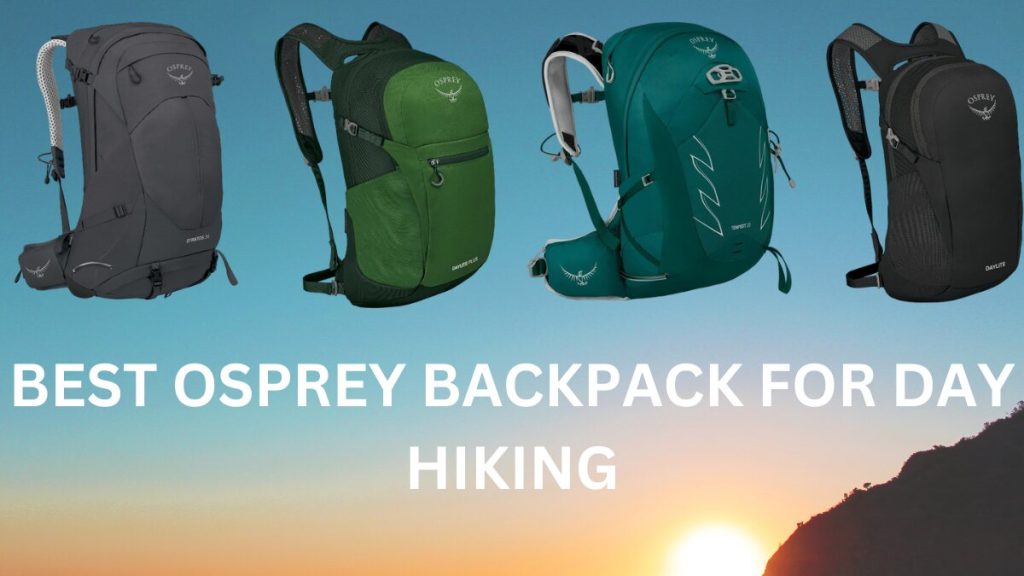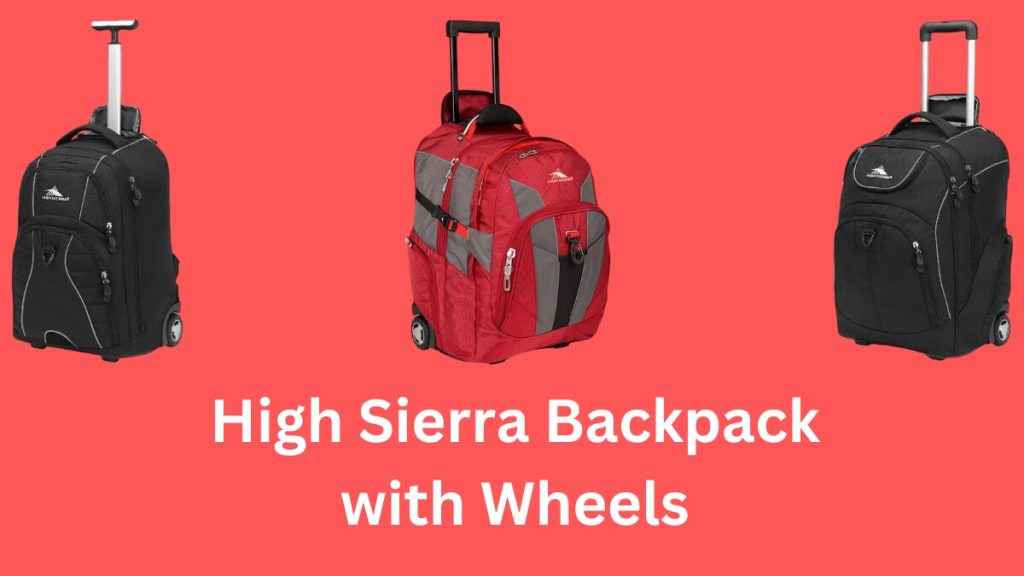Exploring the great outdoors requires the right gear, and when it comes to day hiking, having a reliable backpack can make all the difference. Whether you’re heading out for a short nature walk or a challenging trail adventure, choosing the best Osprey backpack for day hiking ensures you have comfort, durability, and ample storage for all your essentials. Osprey has long been a trusted name in outdoor gear, offering high-quality backpacks designed specifically for hikers who need both functionality and style.
If you’re looking for a pack that provides excellent weight distribution, ergonomic support, and convenient compartments, you’ll want to explore the top models that Osprey has to offer. But what exactly should you look for in an Osprey pack for day trips? Factors such as capacity, ventilation, and fit play a crucial role in determining the best choice for your needs. Some of the most highly recommended options include lightweight yet spacious designs, making them perfect for carrying snacks, water, and extra layers without feeling bulky.
Additionally, with various styles and features available, finding the best Osprey day hiking backpack depends on your personal preferences and hiking style. Whether you prioritize hydration compatibility, a ventilated back panel, or multiple storage compartments, Osprey has a range of backpacks tailored to meet the demands of every hiker. In this guide, we’ll dive into the top-rated Osprey backpacks and help you discover the perfect fit for your next outdoor adventure.
Post Contents
- 0.1 Key Features to Look for in a Day Hiking Backpack
- 0.1.1 Capacity: Ideal Size for Day Hikes (Typically 20-35 Liters)
- 0.1.2 Comfort: Padded Shoulder Straps, Hip Belts, and Back Panel Ventilation
- 0.1.3 Organization: Multiple Compartments, Pockets, and Attachment Points
- 0.1.4 Durability: Materials and Construction Quality
- 0.1.5 Hydration Compatibility: Compatibility with Hydration Reservoirs
- 0.1.6 Weight: Lightweight Design for Ease of Use
- 1 Top Osprey Backpacks for Day Hiking
- 2 How to Choose the Right Osprey Backpack for Your day hiking Needs
- 3 Care and Maintenance Tips for Osprey Backpacks
Key Features to Look for in a Day Hiking Backpack
When choosing a backpack for day hiking, it’s essential to consider several key features that will ensure your pack meets your needs and enhances your hiking experience. Below, we’ll break down the most important factors to look for, explaining why each one matters and how it contributes to a successful day on the trail.
Capacity: Ideal Size for Day Hikes (Typically 20-35 Liters)
The capacity of your backpack is one of the most critical factors to consider when selecting a day hiking pack. For most day hikes, a backpack with a capacity of 20-35 liters is ideal. This size provides enough space to carry all your essentials—such as water, snacks, a first-aid kit, extra layers, and navigation tools—without being overly bulky or heavy.
- Why Capacity Matters: A pack that’s too small won’t have enough room for your gear, forcing you to leave behind important items or carry them in your hands. On the other hand, a pack that’s too large may tempt you to overpack, adding unnecessary weight and strain to your hike.
- What to Pack: For a day hike, your backpack should comfortably hold:
- Hydration: A water bottle or hydration reservoir (2-3 liters).
- Food: Snacks, lunch, and energy bars.
- Clothing: Lightweight layers, a rain jacket, or a hat.
- Essentials: First-aid kit, map, compass, headlamp, and sunscreen.
- Extras: Camera, binoculars, or a lightweight sit pad.
Choosing the right capacity ensures you have everything you need while keeping your load manageable and comfortable.
Comfort: Padded Shoulder Straps, Hip Belts, and Back Panel Ventilation
Comfort is paramount when it comes to day hiking backpacks. A well-designed pack will distribute weight evenly across your body, reducing strain on your shoulders, back, and hips. Key comfort features to look for include:
- Padded Shoulder Straps: Wide, cushioned straps help prevent digging or chafing, especially when carrying heavier loads.
- Hip Belts: A supportive hip belt transfers weight from your shoulders to your hips, which are better equipped to handle the load. Look for a padded, adjustable hip belt for a secure and comfortable fit.
- Back Panel Ventilation: Hiking can be strenuous, and a sweaty back can make the experience uncomfortable. Look for a backpack with a ventilated back panel or mesh design that promotes airflow and keeps you cool.
Comfort is especially important on longer hikes or when carrying heavier loads. A pack that fits well and feels good on your body will allow you to focus on the trail rather than your discomfort.
Organization: Multiple Compartments, Pockets, and Attachment Points
Staying organized on the trail is essential for efficiency and convenience. A well-organized backpack allows you to access your gear quickly without having to dig through a cluttered main compartment. Look for the following organizational features:
- Multiple Compartments: A separate compartment for a hydration reservoir, a front pocket for small items, and a main compartment for bulkier gear.
- Zippered Pockets: Ideal for storing valuables like keys, a phone, or a wallet.
- Attachment Points: Loops or straps for securing trekking poles, ice axes, or other gear externally.
- Top Lid Pocket: A convenient spot for items you need to access frequently, such as sunscreen or snacks.
Good organization not only saves time but also ensures that your gear is secure and easy to find when you need it.
Durability: Materials and Construction Quality
A day hiking backpack is an investment, and you want one that will last for many adventures. Durability is determined by the quality of materials and construction. Look for:
- High-Quality Fabrics: Ripstop nylon or polyester are common materials used in durable backpacks. These fabrics are lightweight yet resistant to tears and abrasions.
- Reinforced Stitching: Double or triple stitching in high-stress areas (like shoulder straps and hip belts) ensures the pack can withstand heavy use.
- Weather Resistance: While not all daypacks are fully waterproof, many feature water-resistant coatings or include a rain cover to protect your gear in wet conditions.
A durable backpack will stand up to the rigors of the trail, whether you’re hiking through dense forests, scrambling over rocks, or facing unpredictable weather.
Hydration Compatibility: Compatibility with Hydration Reservoirs
Staying hydrated is crucial on any hike, and many hikers prefer using a hydration reservoir (also known as a bladder) over traditional water bottles. Look for a backpack that is hydration-compatible, with features such as:
- Sleeve for Hydration Reservoir: A dedicated sleeve inside the pack to hold the bladder securely.
- Tube Routing: Clips or loops to route the hydration tube over your shoulder for easy access.
- Quick-Refill Access: A wide-mouth opening or side zipper for refilling the reservoir without removing it from the pack.
Hydration compatibility adds convenience and ensures you can drink water on the go without stopping to unpack your bag.
Weight: Lightweight Design for Ease of Use
For day hiking, a lightweight backpack is essential. Carrying unnecessary weight can lead to fatigue and reduce your enjoyment of the hike. Look for a pack that balances durability with a lightweight design. Features that contribute to a lighter pack include:
- Minimalist Design: Fewer unnecessary features or heavy materials.
- Lightweight Fabrics: High-quality materials that are strong yet lightweight.
- Streamlined Construction: Avoiding bulky padding or excessive compartments.
A lightweight pack allows you to move more freely and conserve energy, making your hike more enjoyable and less tiring.
When selecting a day hiking backpack, it’s important to consider capacity, comfort, organization, durability, hydration compatibility, and weight. Each of these features plays a crucial role in ensuring your backpack meets your needs and enhances your hiking experience. By carefully evaluating these factors, you can choose a pack that fits your style of hiking and provides the functionality and comfort you need for a successful day on the trail.
Top Osprey Backpacks for Day Hiking
Osprey offers a wide range of backpacks designed to meet the needs of different hikers, from casual day-trippers to seasoned adventurers. Below, we’ll explore some of the best Osprey backpacks for day hiking, highlighting their key features and ideal use cases.
A. Osprey Talon/Tempest Series
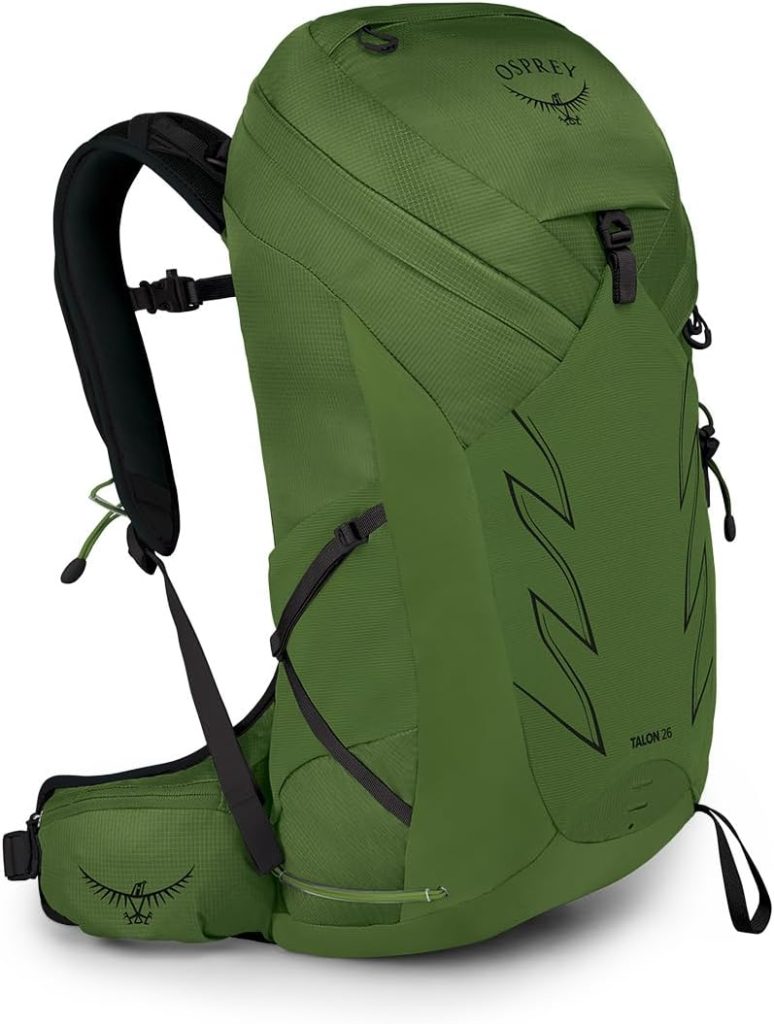
The Osprey Talon (men’s) and Tempest (women’s) series are among the most popular choices for day hikers. These packs are designed to strike a perfect balance between comfort and functionality, making them a versatile option for a variety of trails.
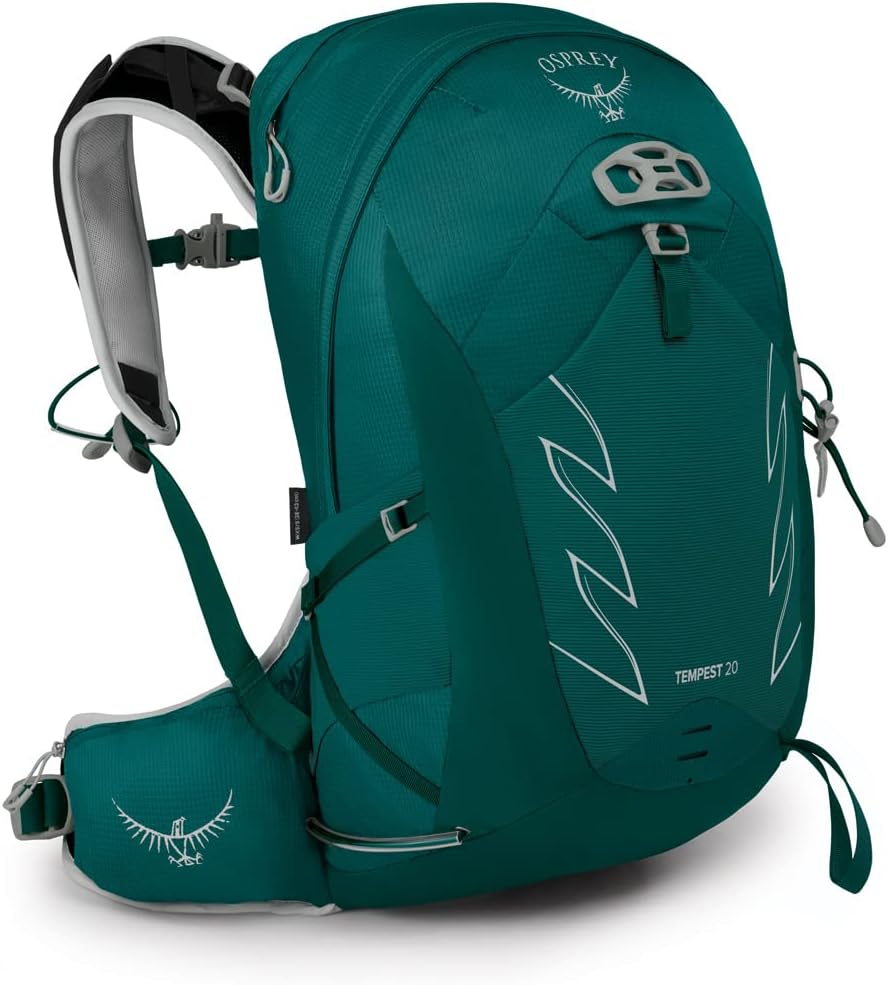
Key Features:
- Lightweight Design: Constructed with durable yet lightweight materials, these packs won’t weigh you down.
- Ventilated Back Panel: The AirSpeed™ suspended mesh back panel provides excellent airflow, keeping you cool during strenuous hikes.
- Adjustable Harness: The Stow-on-the-Go™ trekking pole attachment and adjustable harness ensure a customized fit for all body types.
- Ideal For: Hikers who want a reliable, feature-rich backpack that offers comfort and practicality without unnecessary bulk. Whether you’re tackling a steep ascent or enjoying a leisurely trail, the Talon/Tempest series delivers.
B. Osprey Stratos/Sirrus Series
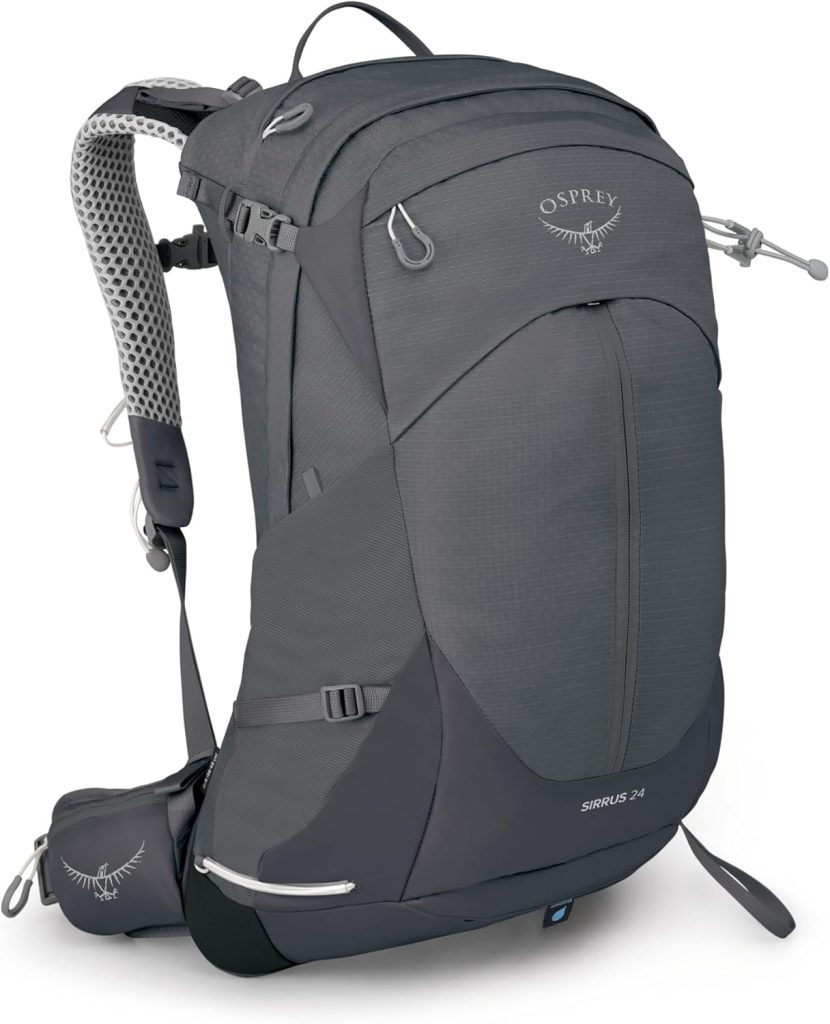
For hikers who prioritize comfort and support, the Osprey Stratos (men’s) and Sirrus (women’s) series are excellent choices. These packs are designed with advanced suspension systems to provide maximum comfort, even on longer day hikes.
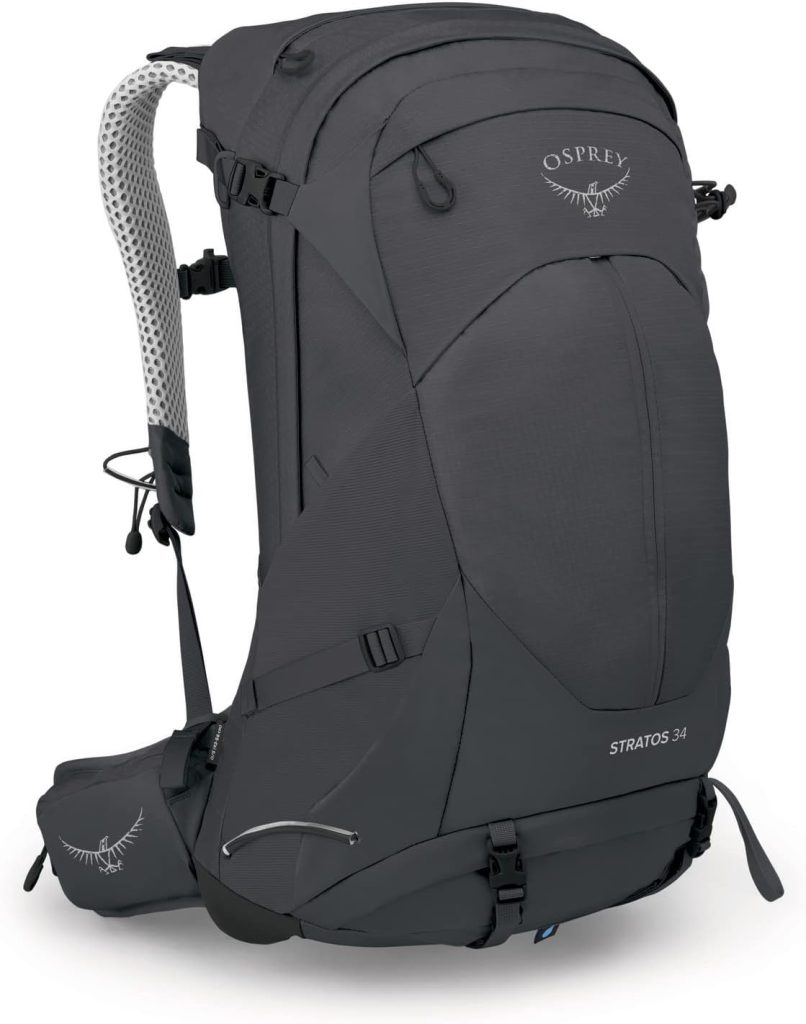
Key Features:
- Anti-Gravity Suspension System: This innovative system evenly distributes weight, reducing strain on your back and shoulders.
- Ample Storage: Multiple compartments, including a front shove-it pocket and a floating lid, offer plenty of space for gear.
- Durability: Made with rugged materials, these packs are built to withstand tough conditions.
- Ideal For: Hikers who need extra support and storage for longer hikes or heavier loads. The Stratos/Sirrus series is perfect for those who want a pack that feels like an extension of their body.
C. Osprey Hikelite Series
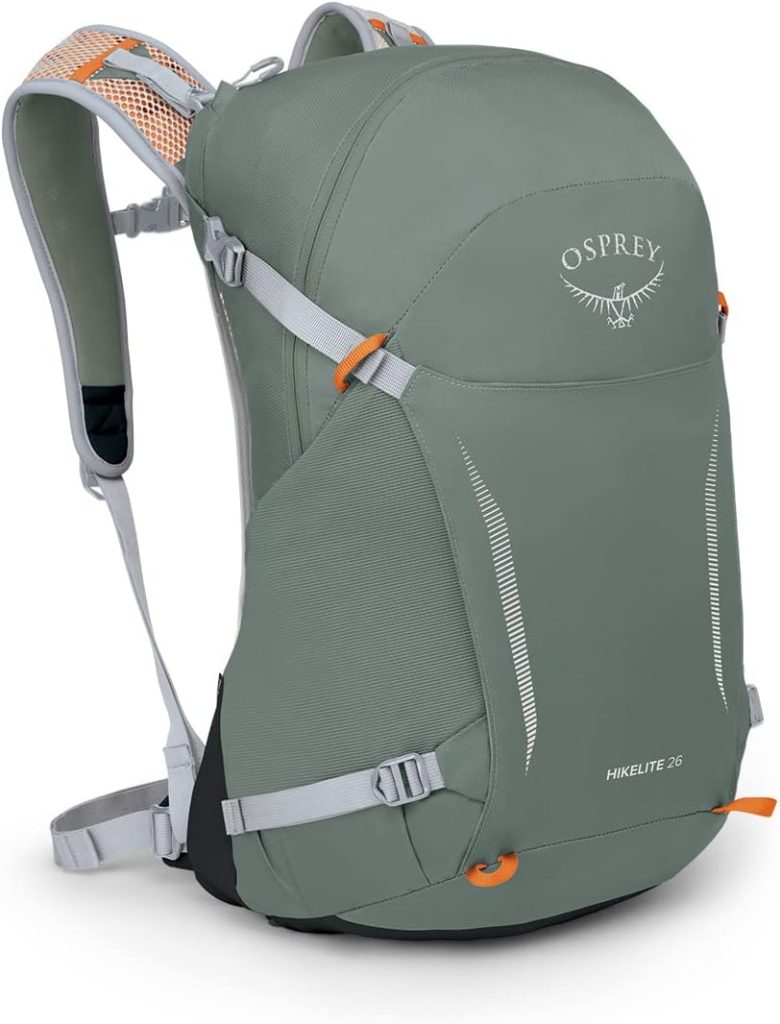
If you’re a minimalist hiker or prefer shorter day hikes, the Osprey Hikelite series is a fantastic option. These unisex packs are designed to be lightweight and compact, without sacrificing essential features.
Key Features:
- Lightweight and Compact: The Hikelite series is perfect for carrying just the essentials, making it ideal for quick outings.
- Integrated Rain Cover: A built-in rain cover ensures your gear stays dry in unexpected weather.
- Simple Design: Easy-to-use zippers and a single main compartment keep things straightforward.
- Ideal For: Hikers who prefer a no-frills, lightweight pack for shorter trails or those who want a secondary pack for travel and outdoor activities.
D. Osprey Daylite/Daylite Plus
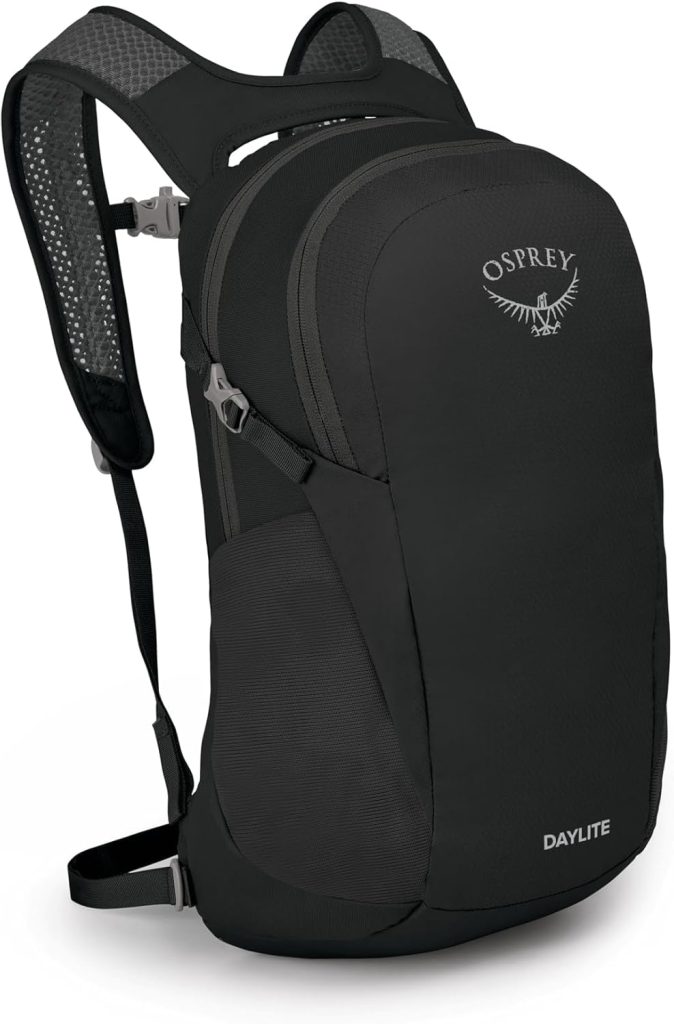
For casual hikers or those looking for an affordable, versatile option, the Osprey Daylite and Daylite Plus are excellent choices. These unisex packs are compact yet functional, making them a favorite among outdoor enthusiasts.
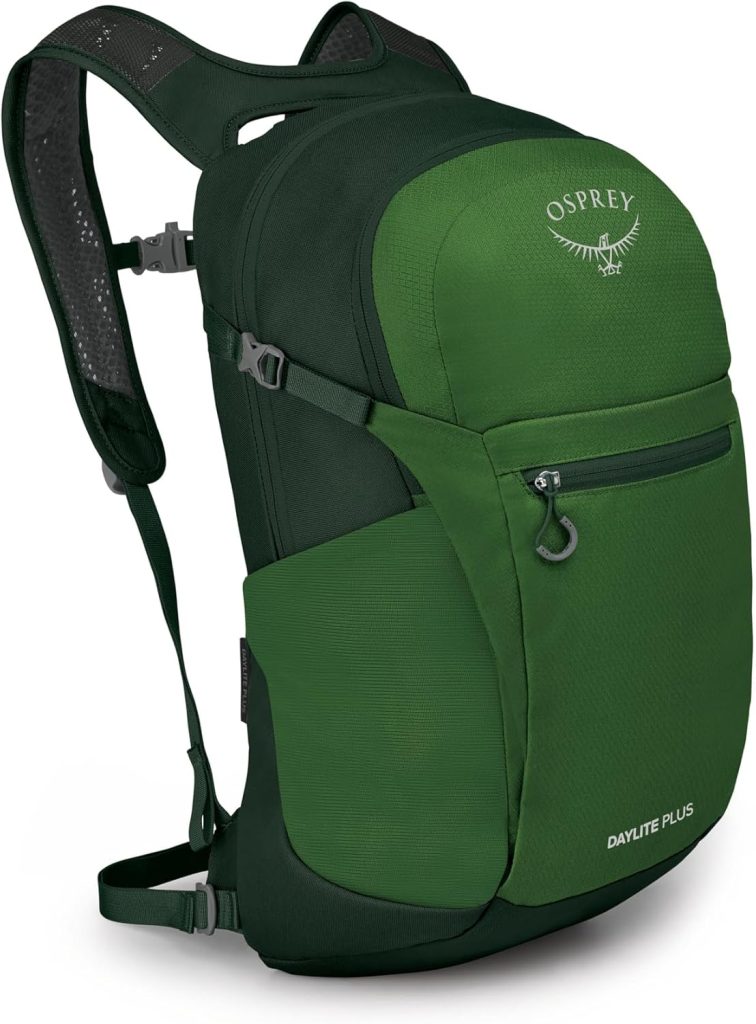
Key Features:
- Compact Size: With a capacity of 13-20 liters, these packs are perfect for short hikes or as a supplementary bag.
- Affordability: The Daylite series offers great value without compromising on quality.
- Versatility: These packs can double as travel daypacks or commuting bags, making them a practical addition to your gear collection.
- Ideal For: Casual hikers, travelers, or anyone needing a lightweight, simple pack for everyday adventures.
When it comes to finding the best Osprey backpack for day hiking, the Talon/Tempest, Stratos/Sirrus, Hikelite, and Daylite series each offer unique features to suit different needs. Whether you prioritize comfort, durability, or simplicity, Osprey has a pack that will enhance your hiking experience.
Comparison of Top Osprey Day Hiking Backpacks
To help you choose the best Osprey backpack for day hiking, we’ve created a side-by-side comparison of the featured models: the Talon/Tempest, Stratos/Sirrus, Hikelite, and Daylite/Daylite Plus series. This comparison covers key aspects such as capacity, weight, price, and best use cases, along with the pros and cons of each model.
Side-by-Side Comparison
| Model | Capacity | Weight | Price Range | Best Use Cases |
|---|---|---|---|---|
| Talon/Tempest | 22-33 liters | 0.7-1.3 kg | $120-$160 | Versatile day hikes, moderate to long trails |
| Stratos/Sirrus | 24-36 liters | 1.1-1.5 kg | $150-$200 | Longer day hikes, heavier loads |
| Hikelite | 18-26 liters | 0.5-0.8 kg | $80-$120 | Minimalist hikes, short trails |
| Daylite/Daylite Plus | 13-20 liters | 0.3-0.6 kg | $50-$80 | Casual hikes, travel, commuting |
Pros and Cons of Each Osprey hiking backpack Model
A. Osprey Talon/Tempest Series
- Pros:
- Lightweight and breathable, thanks to the AirSpeed™ back panel.
- Adjustable harness and Stow-on-the-Go™ trekking pole attachment for added convenience.
- Versatile design suitable for a wide range of day hikes.
- Cons:
- Limited padding on the hip belt, which may not suit those carrying heavier loads.
- Higher price point compared to simpler models like the Daylite.
Best For: Hikers who want a balanced pack for moderate to long day hikes, offering a mix of comfort, ventilation, and functionality.
B. Osprey Stratos/Sirrus Series
- Pros:
- Exceptional comfort with the Anti-Gravity suspension system, ideal for longer hikes.
- Ample storage and organization options, including a floating lid and front shove-it pocket.
- Durable construction designed to handle rugged terrain.
- Cons:
- Heavier than other models, which may not appeal to minimalist hikers.
- Higher price range, making it less accessible for casual hikers.
Best For: Hikers who prioritize comfort and support on longer or more challenging day hikes, especially when carrying heavier gear.
C. Osprey Hikelite Series
- Pros:
- Extremely lightweight and compact, perfect for minimalist hikers.
- Integrated rain cover provides added protection in wet conditions.
- Affordable price point for a high-quality pack.
- Cons:
- Limited capacity and organization compared to larger models.
- Less padding and support, which may not be ideal for longer hikes.
Best For: Minimalist hikers or those on shorter trails who want a lightweight, no-frills pack with essential features.
D. Osprey Daylite/Daylite Plus
- Pros:
- Compact and lightweight, making it ideal for casual hikes or as a secondary pack.
- Affordable and versatile, suitable for hiking, travel, or commuting.
- Simple design with easy access to essentials.
- Cons:
- Limited capacity and storage options, not suitable for longer hikes or heavy loads.
- Minimal padding and support, which may not be comfortable for extended use.
Best For: Casual hikers, travelers, or anyone needing a lightweight, budget-friendly pack for short outings or everyday use.
Key Takeaways
- Talon/Tempest: Best for hikers seeking a versatile, well-ventilated pack for moderate to long day hikes.
- Stratos/Sirrus: Ideal for those who need maximum comfort and support for longer hikes or heavier loads.
- Hikelite: Perfect for minimalist hikers or short trails, offering lightweight convenience and weather protection.
- Daylite/Daylite Plus: Great for casual hikers or as a secondary pack, combining affordability with practicality.
Choosing the best Osprey backpack for day hiking depends on your specific needs, hiking style, and budget. The Talon/Tempest series offers a balanced mix of comfort and functionality, while the Stratos/Sirrus series excels in providing support for longer hikes. The Hikelite series is ideal for minimalist hikers, and the Daylite/Daylite Plus is a versatile, budget-friendly option for casual use. By comparing the pros and cons of each model, you can find the perfect pack to enhance your day hiking adventures.
How to Choose the Right Osprey Backpack for Your day hiking Needs
Choosing the right Osprey backpack can significantly enhance your outdoor experience. It’s crucial to consider several factors to ensure you select a pack that perfectly suits your needs.
Consider Your Hiking Style and Duration:
The type of hiking you do plays a major role in backpack selection. For day hikes, a smaller pack (20-35 liters) will suffice, carrying essentials like water, snacks, and a light jacket. Backpacking trips lasting several days require larger packs (50-70 liters or more) to accommodate gear for camping, cooking, and sleeping. Consider the terrain as well. If you’re tackling challenging trails, a pack with a good suspension system and hip belt will be essential for weight distribution. Fastpacking or trail running might call for a lightweight, minimalist pack.
Evaluate the Importance of Features:
Osprey backpacks come with a variety of features. Hydration compatibility is crucial for staying hydrated on the trail. Look for packs with dedicated hydration sleeves and ports. Ventilation is also important, especially in warm climates. Features like mesh back panels promote airflow and prevent excessive sweating. Other features to consider include:
- Pockets and Compartments: Think about how you organize your gear. Do you need multiple compartments for easy access, or do you prefer a simpler design?
- Attachment Points: If you carry trekking poles, ice axes, or other gear, ensure the pack has appropriate attachment points.
- Rain Cover: A built-in rain cover is essential for keeping your gear dry in wet weather.
- Hip Belt: A well-padded hip belt is vital for transferring the pack’s weight to your hips, reducing strain on your shoulders.
Try on Backpacks for Fit and Comfort:
The most important aspect of choosing a backpack is ensuring a proper fit. An ill-fitting pack can lead to discomfort, chafing, and even injury. Visit a store where you can try on different backpacks. Load the pack with some weight (books or water bottles work well) to simulate real-world conditions. Pay attention to how the pack feels on your shoulders, back, and hips. The hip belt should sit comfortably on your hips, and the shoulder straps should not dig into your shoulders. Osprey offers different torso lengths, so it’s important to get measured to ensure you choose the correct size. Don’t hesitate to ask for assistance from store staff.
Care and Maintenance Tips for Osprey Backpacks
Proper care and maintenance can significantly extend the lifespan of your Osprey backpack. By following a few simple guidelines, you can keep your pack in top condition for years to come.
Cleaning and Storage Recommendations:
After each trip, it’s a good idea to clean your Osprey hiking backpack. Remove any dirt, debris, or food particles. For light cleaning, you can wipe the pack down with a damp cloth. For more thorough cleaning, you can hand wash the pack with mild soap and water. Avoid using harsh detergents or bleach, as these can damage the fabric and coatings. Never put your backpack in a washing machine or dryer. Once you’ve washed the pack, allow it to air dry completely before storing it. When storing your backpack, keep it in a cool, dry place away from direct sunlight and extreme temperatures. Avoid storing the pack in a compressed state, as this can damage the padding and frame.
How to Extend the Lifespan of Your Backpack:
In addition to regular cleaning, there are other steps you can take to prolong the life of your Osprey backpack:
- Inspect Regularly: Check your backpack for any signs of wear and tear, such as tears, broken zippers, or loose stitching. Addressing these issues early can prevent them from becoming bigger problems.
- Use a Rain Cover: Even if your pack has a DWR (durable water repellent) coating, using a rain cover in heavy rain will help protect the fabric and prevent it from becoming saturated.
- Pack Carefully: Avoid overpacking your backpack, as this can strain the seams and zippers. Distribute the weight evenly to prevent stress on specific areas.
- Protect from Sharp Objects: Be careful when packing sharp objects, such as knives or trekking poles. Use protective covers or sheaths to prevent them from damaging the pack.
- Store Properly: As mentioned earlier, proper storage is crucial. Avoid storing your backpack in direct sunlight or in damp conditions.
By following these care and maintenance tips, you can ensure that your Osprey backpack remains a reliable companion on all your adventures for many years.
Conclusion: best osprey backpack for day hiking
Choosing the best Osprey backpack for day hiking is a decision that can significantly enhance your outdoor adventures. Osprey’s reputation for quality, innovation, and comfort ensures that each of their backpacks is designed to meet the unique needs of hikers, whether you’re tackling rugged mountain trails or enjoying a leisurely stroll through the woods. From the versatile Talon/Tempest series to the supportive Stratos/Sirrus models, the minimalist Hikelite, and the budget-friendly Daylite/Daylite Plus, there’s an Osprey backpack for every type of hiker. By considering factors such as capacity, comfort, durability, and hydration compatibility, you can find a pack that not only carries your gear but also makes your hike more enjoyable and stress-free.
We hope this guide has helped you narrow down your options and provided valuable insights into the features that matter most for day hiking. Remember, the right backpack is more than just a piece of gear—it’s your trusted companion on the trail, ensuring you’re prepared for whatever the journey brings.
If you found this post helpful, please like and share it with fellow hikers and outdoor enthusiasts. Your support helps us continue creating content that empowers adventurers like you. We’d also love to hear from you—let us know in the comments which Osprey backpack is your favorite or share your own day hiking experiences. Happy trails, and may your next hike be your best one yet!

